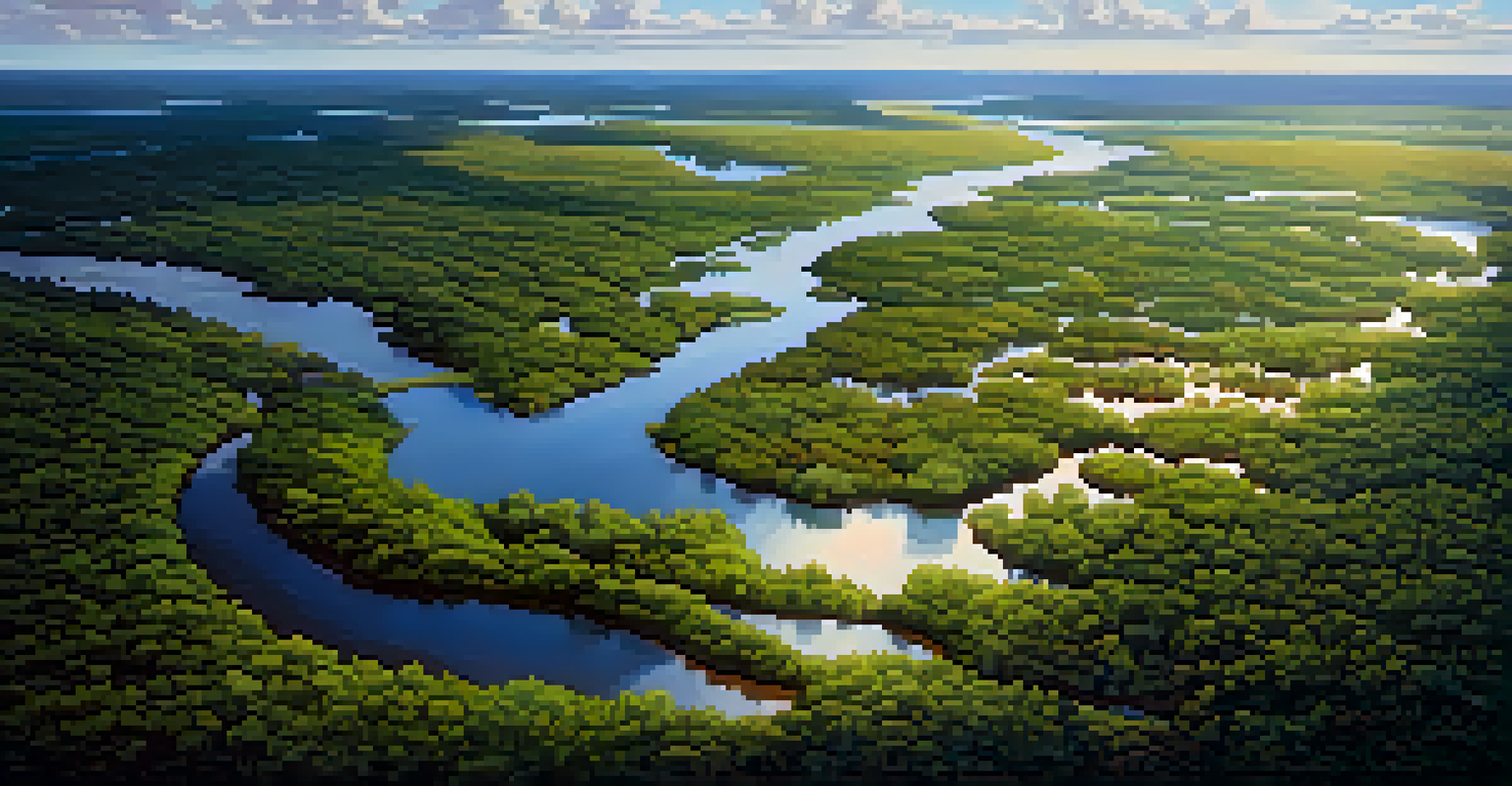How Nature Reserves Contribute to Environmental Conservation

Nature Reserves: Safeguarding Biodiversity on Our Planet
Nature reserves are designated areas that provide a safe haven for various species, protecting them from habitat loss and extinction. By preserving these natural habitats, we ensure that diverse ecosystems can thrive, which is crucial for maintaining biodiversity. For instance, the Yellowstone National Park serves as a powerful example, harboring a multitude of species, from wolves to grizzly bears, all coexisting in their natural environment.
In every walk with nature one receives far more than he seeks.
These reserves act like nature's insurance policy, allowing ecosystems to flourish and adapt over time. When species are protected within these areas, they have the opportunity to reproduce and maintain stable populations, contributing to a healthier planet. In essence, nature reserves serve as a refuge where the intricate web of life can continue without the threats posed by urbanization or industrialization.
Moreover, protecting biodiversity is not just about saving animals and plants; it directly impacts human survival. Healthy ecosystems provide essential services, such as clean air, water, and fertile soil. By conserving these areas, we safeguard our own future while nurturing the rich tapestry of life on Earth.
Nature Reserves and Climate Change Mitigation
Nature reserves play a crucial role in mitigating climate change by acting as carbon sinks. Forests, wetlands, and grasslands within these areas absorb carbon dioxide from the atmosphere, helping to reduce greenhouse gas levels. This natural process is vital, especially as the world grapples with rising temperatures and erratic weather patterns.

For example, the Amazon rainforest, often referred to as the 'lungs of the Earth,' sequesters vast amounts of carbon. However, when these areas are threatened by deforestation and development, we lose not only the trees but also their ability to combat climate change. By establishing and maintaining nature reserves, we protect these critical ecosystems from degradation and ensure they continue to function as effective climate regulators.
Nature Reserves Protect Biodiversity
Nature reserves serve as safe havens for diverse species, safeguarding ecosystems and ensuring the survival of various plants and animals.
Additionally, preserving natural areas enhances their resilience to climate impacts. Healthy ecosystems are better equipped to withstand changes, such as increased flooding or droughts, thereby providing stability for both wildlife and local communities. In this way, nature reserves act as a buffer against the unpredictable effects of climate change.
Educational Opportunities Offered by Nature Reserves
Nature reserves serve as outdoor classrooms, providing invaluable educational opportunities for people of all ages. They offer hands-on experiences that foster a deeper understanding of ecology and conservation. Visitors can participate in guided tours, workshops, or volunteer programs that highlight the importance of preserving natural habitats.
The clearest way into the Universe is through a forest wilderness.
For instance, many reserves organize school field trips that immerse students in nature, encouraging them to connect with the environment. This experiential learning not only cultivates a sense of responsibility for the planet but also inspires the next generation of conservationists. Through these programs, children learn firsthand about the delicate balance of ecosystems and the role they play in protecting them.
Moreover, nature reserves often partner with universities and research institutions to conduct scientific studies. These collaborations advance our understanding of various species and ecosystems, contributing to more effective conservation strategies. With each discovery, we move closer to finding solutions to pressing environmental challenges.
Cultural Heritage and Nature Reserves
Nature reserves are not only vital for ecological preservation but also for protecting cultural heritage. Many indigenous communities have lived in harmony with these landscapes for generations, and their traditional knowledge is invaluable for conservation efforts. By recognizing the cultural significance of these areas, we can foster a greater appreciation for the interconnectedness of people and nature.
For example, the Torres Strait Islands in Australia illustrate how indigenous practices contribute to the management of marine resources. Local knowledge regarding sustainable fishing and land use can greatly enhance conservation initiatives, ensuring that both nature and culture thrive. By involving indigenous communities in reserve management, we create a holistic approach to conservation that respects and honors their contributions.
Economic Boost from Eco-Tourism
Nature reserves contribute significantly to local economies through eco-tourism, creating jobs and supporting businesses while promoting conservation.
Furthermore, nature reserves often house historical sites and artifacts that tell the story of human interaction with the environment. By protecting these areas, we preserve not just biodiversity but also the rich tapestry of human history intertwined with nature. This cultural preservation is essential for maintaining identity and fostering a sense of belonging among communities.
Economic Benefits of Nature Reserves
While nature reserves are often viewed primarily through an environmental lens, they also contribute significantly to local economies. Eco-tourism, which focuses on responsible travel to natural areas, generates income and employment opportunities in surrounding communities. By attracting visitors, reserves help support local businesses, from hotels to restaurants, while promoting conservation.
Take Costa Rica, for instance, a country renowned for its commitment to protecting biodiversity. The establishment of national parks and reserves has transformed the economy by prioritizing sustainable tourism. Tourists flock to see the rich wildlife and stunning landscapes, providing a financial incentive to preserve these natural treasures for future generations.
Additionally, nature reserves can enhance property values in nearby areas. When a natural landscape is preserved, it often increases the desirability of the surrounding region, benefiting local homeowners and businesses. Thus, investing in conservation pays dividends not only for the environment but also for the economy.
Restoration of Ecosystems Within Nature Reserves
Nature reserves play a pivotal role in the restoration of ecosystems that have been damaged or degraded. Through dedicated conservation efforts, these areas can be rehabilitated to support native species and restore ecological balance. This restorative process is essential for reviving habitats that have suffered from deforestation, pollution, or invasive species.
For instance, the restoration projects in California's coastal wetlands demonstrate how active intervention can rejuvenate ecosystems. By removing invasive plant species and reintroducing native flora, these efforts help restore the natural habitat for wildlife. Over time, these actions lead to increased biodiversity and improved ecosystem services, such as water filtration and flood control.
Nature Reserves Aid Climate Action
By acting as carbon sinks, nature reserves help mitigate climate change effects, absorbing greenhouse gases and enhancing ecosystem resilience.
Moreover, successful ecosystem restoration in nature reserves can serve as a model for other regions facing similar challenges. By showcasing the positive outcomes of these initiatives, we can inspire global efforts to prioritize ecological restoration. It's a reminder that nature has an incredible ability to bounce back when given the chance.
Challenges Facing Nature Reserves and Conservation Efforts
Despite their critical role in environmental conservation, nature reserves face numerous challenges that threaten their effectiveness. Issues such as climate change, invasive species, and human encroachment can significantly undermine conservation efforts. Understanding these challenges is crucial for developing effective strategies to protect these vital ecosystems.
For example, rising temperatures can alter habitats, forcing species to migrate or adapt in ways they may not be able to. Invasive species can outcompete native flora and fauna, disrupting the delicate balance within ecosystems. These pressures require ongoing monitoring and adaptive management to ensure that reserves continue to serve their intended purpose.

Additionally, funding and support for nature reserves can be inconsistent, impacting their management and conservation initiatives. Engaging local communities, fostering partnerships, and raising public awareness are essential steps in overcoming these challenges. By working together, we can ensure that nature reserves remain strongholds for biodiversity and environmental health.